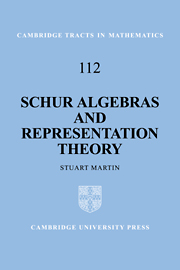Book contents
- Front matter
- Contents
- Introduction
- 1 Polynomial functions and combinatorics
- 2 The Schur algebra
- 3 Representation theory of the Schur algebra
- 4 Schur functors and the symmetric group
- 5 Block theory
- 6 The q-Schur algebra
- 7 Representation theory of Sq(n, r)
- Appendix: a review of algebraic groups
- References
- Index of Notation
- Index of Terms
Appendix: a review of algebraic groups
Published online by Cambridge University Press: 22 September 2009
- Front matter
- Contents
- Introduction
- 1 Polynomial functions and combinatorics
- 2 The Schur algebra
- 3 Representation theory of the Schur algebra
- 4 Schur functors and the symmetric group
- 5 Block theory
- 6 The q-Schur algebra
- 7 Representation theory of Sq(n, r)
- Appendix: a review of algebraic groups
- References
- Index of Notation
- Index of Terms
Summary
Inevitably in this text, we have needed to use ideas from the theory of semisimple and reductive algebraic groups, though in practice we have been mostly concerned with these ideas as they pertain to GLn or SLn. There is an ample literature on algebraic group theory: proofs of all the assertions below may be found either in the standard texts of Humphreys [1987] or Jantzen [1987, II 1, 2]. I urge you to read this Appendix (if at all) only after digesting Chapter 1. We assume throughout that K is algebraically closed.
Linear algebraic groups: definitions
Let us view the polynomial ring K[x1,…,xn] as the polynomial functions on an n-dimensional space, An(K), over K. Regard An(K) as an affine space, as opposed to a vector space, since, given any point a = (a1,…,an) in it we cannot distinguish K[x1,…,xn] from K[x1 – a1,…,xn – an] (so a becomes the origin with this new viewpoint). By an affine variety we mean a collection of points in An(K) given by the simultaneous vanishing of a set of polynomials.
Definition 1 A linear algebraic groupG over K is an affine variety V furnished with a compatible group structure. This means that multiplication V × V → V and inversion V → V are morphisms of varieties (which is to say that the coordinates of the map are given by polynomials). Denote the affine algebra or coordinate ring of V by K[V].
- Type
- Chapter
- Information
- Schur Algebras and Representation Theory , pp. 212 - 219Publisher: Cambridge University PressPrint publication year: 1994



